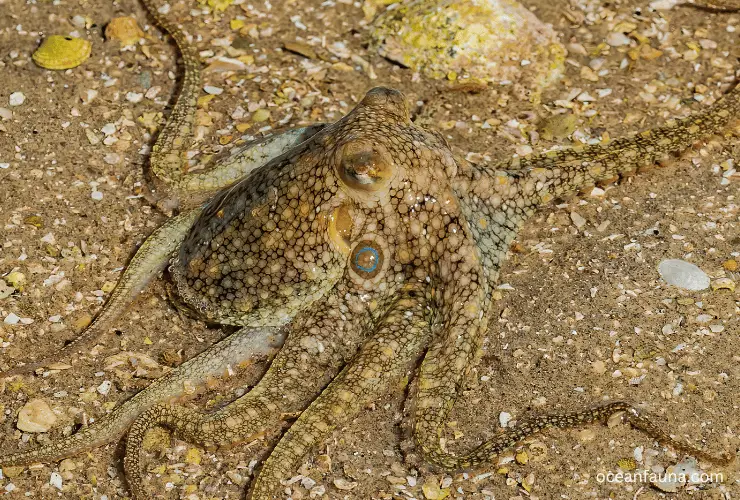The California two-spot octopus, also known as “bimac” is a species of octopus found in the Pacific Ocean (also on the coasts of California). It has distinctive blue eyespots on its head. Bimacs typically live for about two years and are closely related to Verrill’s two-spot octopus. In 2015, scientists sequenced the bimac’s genome.
The California two-spot octopus is a fascinating creature with many unique characteristics. For example, bimacs are very intelligent and have been observed opening jars and solving puzzles. Additionally, they have three hearts and blue, copper-based blood, which helps transport oxygen throughout their body.
Do you have an interest in deep diving into the sea for insights about this marine creature? These fascinating creatures are full of surprises and have much more to offer than just their distinctive blue eyespots. Keep reading to discover more fun facts about the California two-spot octopus!
About California Two-Spot Octopus: A Quick Biology
Take a look at the quick biology of the California two-spot octopus in the table below for more interesting facts about this amazing creature given by “Morro Bay National Estuary Program”. (Source)
| Parameters | Details |
| Scientific name | Octopus bimaculoides (Pickford & McConnaughey, 1949) |
| Kingdom | Animalia |
| Family | Octopodidae |
| Genus | Octopus |
| Phylum | Mollusca |
| Class | Cephalopoda |
| Order | Octopoda |
| Species | O. bimaculoides |
| Habitat | Intertidal and subtidal (up to 3 meters or 15 feet depth) |
| Life Span | 1 to 1.5 years in the wild, 2 years in captivity |
| Diet | Limpets, snails, black abalone, and small fish |
| Geography | Coastal waters from the intertidal down to at least 20 m (65 ft) in the eastern Pacific along mid- and southern California and the western side of the Baja California Peninsula in Mexico |
| Weight | 1.5 kg |
| Length | 18 inches long (45 cm) |
| Synonyms | Bimac, Octopus Bimaculoids |
California Two-Spot Octopus Encyclopedia: Top Interesting Facts
In this encyclopedia, we’ve compiled the top interesting facts about this incredible octopus. From their unique abilities to their quirky behaviors, thus, everything is covered here. Let’s read on to know about it without any further exaggeration.
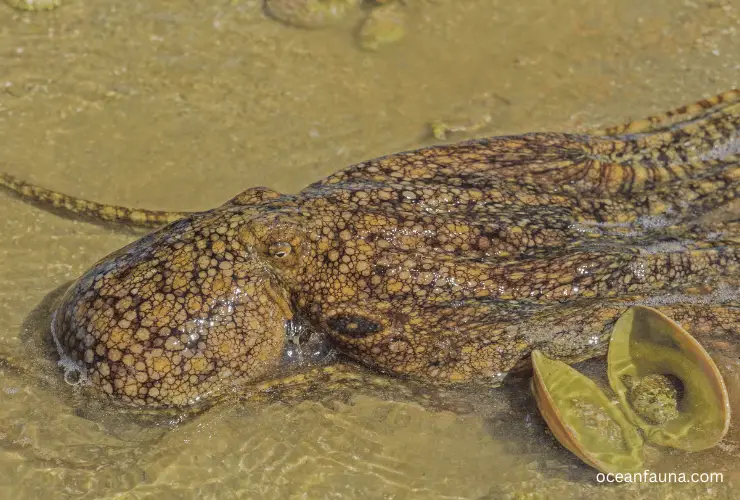
1. Etymology
Wikipedia organization’s researchers have investigated the etymology of California two-spot octopus. So, let’s discover the interesting etymology of Octopus Bimaculoids: (source)
“The name California two-spot octopus comes from the location where it is commonly found – California. Its scientific name is Octopus bimaculoides which belongs to the Octopodidae family. The “bimaculoides” part of the name is derived from the Latin words “bi” meaning two and “maculoides” meaning spotted.
This is because the octopus has two distinctive spots on its body. The genus name, Octopus, comes from the Greek words “okto” meaning eight, and “pous” meaning foot, which refers to the octopus’s eight arms.”
Thus, we can say that this octopus is called after the false eye spot or ocellus located under each real eye. The ocelli are circular and have an iridescent blue chain-link pattern surrounded by black.
2. Appearance
Overall, Octopus bimaculoides is a fascinating animal with unique physical characteristics. Its characteristics make it an interesting subject of study for scientists and nature enthusiasts alike. Let’s see what it looks like so that you can easily recognize it whenever you come into contact with them.
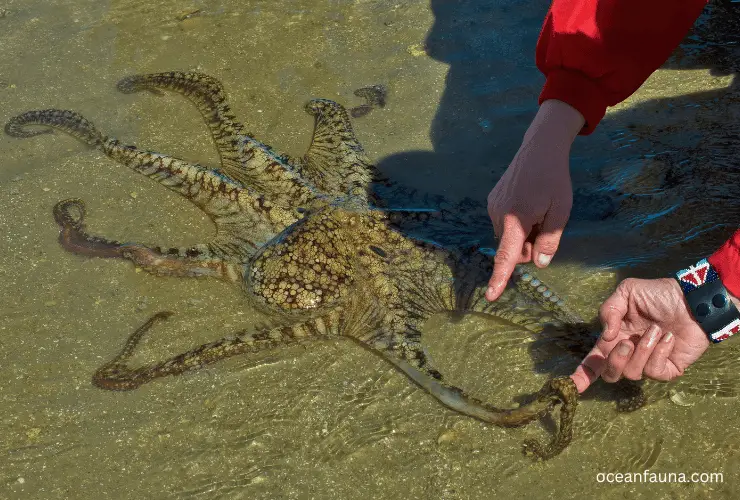
According to Wikipedia organization’s authors, it possesses the following physical characteristics:
“Octopus bimaculoides can grow up to a mantle size of 17.5 cm (7 inches) and have arms that can reach up to 58 cm (23 inches). Their skin is usually smooth and lacks any heavy texture. The octopus comes in a variety of colors, but it is commonly seen in grey with yellow splotches.
They have a remarkable ability to change the color of their skin to match the surrounding environment. It allows them to blend in with their surroundings. This process is known as crypsis. And if we talk about its weight then it can be 1.5 kg.” (Source)
3. Camouflage Mechanism
California two-spot octopus can change their skin color using various structures such as chromatophores, iridophores, and leucophores.
- Chromatophores are pigment sacs that can expand and contract with the help of attached muscle fibers.
- Leucophores reflect white light, allowing for the reflection of the prevalent wavelengths in their habitat, creating disruptive patterns.
- Iridophores are another type of skin structure that help octopuses change their color and texture. Unlike chromatophores, iridophores contain iridescent platelets that reflect and scatter light. In combination with chromatophores and leucophores, iridophores contribute to the complex and dynamic camouflage abilities of octopuses.
Thus, by using a combination of these skin structures and the brain’s control over their patterning, octopuses can do the following:
- Blend into their environment
- Hide from predators
- Surprise prey
Thus, the above characteristics contribute to the California two-spot octopus’s remarkable camouflage abilities in its natural environment.
4. Genetics
Wikipedia organization’s authors have researched the genetics of this marine creature. Let’s see what they are saying about its genetics: (source)
“New technologies like genome sequencing have revealed an abundance of clustered protocadherins (PCDH) in Octopus bimaculoides. This octopus species have been discovered to possess 168 PCDH genes, with approximately 120 clustered and 50 non-clustered PCDH. The clustering of octopus PCDH in its genome differs from the clustered PCDH in mammals.
Unlike mammalian clustered PCDH, these findings provide new insights into the genetic makeup of octopuses. These discoveries offer opportunities for research on their evolution and behavior. The knowledge gained from this research can help us understand how these creatures have developed their unique abilities. It also provides new insights into the mysteries of the natural world.”
5. Diet and nutrition
The hatchlings of California two-spot octopuses feed on amphipods or mysid shrimp. These tiny creatures provide the necessary nutrients for the young octopuses to grow and develop. As they mature, California two-spot octopuses expand their diet to include a variety of prey.
They are opportunistic feeders and eat whatever they can catch, including crustaceans, fish, and other mollusks. The California two-spot octopus uses its eight arms lined with suckers to grasp prey and bring it to its beak-like mouth. Limpets, snails, black abalone, and small fish are their favorite foods.
Their ability to camouflage and adapt to their surroundings enables them to hunt more efficiently and avoid predators. The diet of the California two-spot octopus is an essential component of their survival and helps maintain the balance of the ecosystem.
6. Reproduction system
The California two-spot octopus can mate at any time of the year, but they typically reproduce during the summer when the water temperature rises. The male octopus inseminates the female with its spermatophores before dying shortly after. The female creates a den and lays thousands of eggs before sealing herself in.
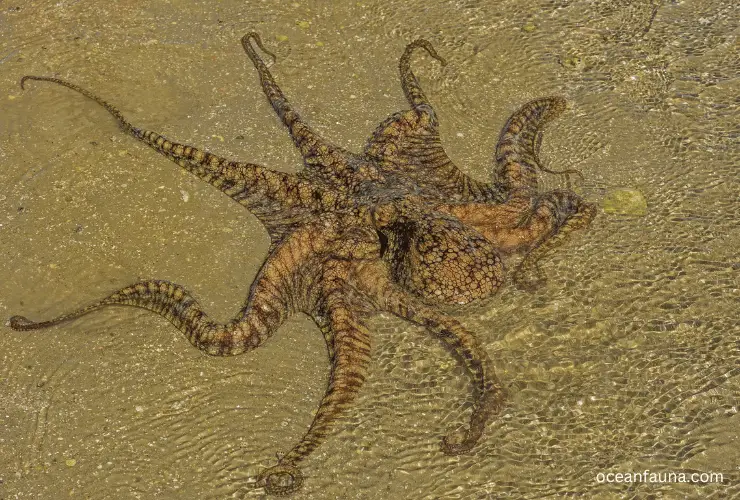
She cares for her eggs by blowing cool water from her siphon to keep them oxygenated. This process can cause the female to die from starvation and exhaustion. The eggs hatch after 150 to 210 days, and the larvae drift with the tide before settling on the ground to begin developing.
Male octopuses die after mating, but female octopuses provide significant parental care by remaining with the eggs, protecting them, and siphoning cool water over them. Females do not feed during this time, often leading to their death. Once the eggs hatch, the larvae become independent.
| Parameters | Description |
| Breeding interval | This octopus bimaculatus breeds once in its lifetime. |
| Breeding season | Mating typically takes place in the summer months, though it can happen year-round. |
| Range number of offspring | 20,000 to 100,000 |
| The average number of offspring | 70,000 |
| Range gestation period | 150 to 210 days |
| Range age at sexual or reproductive maturity (female) | 1 to 2 years |
| Range age at sexual or reproductive maturity (male) | 1 to 2 years |
7. The lifespan of California two-spot octopus
The California two-spot octopus has a lifespan of one to two years. The female signals the end of her life by laying eggs, while both males and females experience senescence. This process marks a decline in their physical abilities and biological functions. It is a natural part of their life cycle and is common among most animals.
Despite their relatively short lifespan, these creatures have a significant impact on their ecosystem. They play an essential role in the food chain and contribute to the overall health of their marine environment. The short lifespan of the California two-spot octopus underscores the importance of preserving and protecting its habitat to ensure its continued survival.
| Parameters | Details |
| Range lifespan Status: captivity | 2 (high) years |
| Typical lifespan Status: wild | 1 to 1.5 years |
| Typical lifespan Status: captivity | 1 to 2 years |
8. Distribution and Habitat
The California two-spot octopus resides in the coastal waters of mid and southern California, as well as the western region of the Baja California Peninsula in Mexico. This species can be found in subtidal areas that extend up to 20 meters in depth.
It can be found in subtidal areas and prefers to hide in rocky reefs or debris. This octopus species is capable of withstanding a broad temperature range of 15-26°C (60-80°F), but it prefers the water to be around 18-22°C (65-72°F). (Source)
9. Ecosystem Roles
Animal Diversity organization’s researchers have explained the ecosystem roles effectively. They said the following: (source)
“California two-spot octopuses play an important role in the food chain as both primary and secondary consumers. They help control the population of smaller mollusks while serving as a food source for larger predators. However, they can also be hosts for parasites such as ectoparasitic flagellates and ciliate protozoans, which live on their gills.
These parasites can affect the octopuses’ health and potentially harm their populations. As a result, monitoring the health of the California two-spot octopuses and the prevalence of parasites is important to maintain their ecological role in the ecosystem.”
10. Behavior
California two-spot octopus possesses the following behaviors:
- California two-spot octopus is nocturnal and active mainly at night.
- They leave their dens to hunt and mate during the night.
- Their highly developed eyes enable them to see in the dark.
- These octopuses roam around searching for food and temporary shelter.
- They do not construct their dens but compete with other octopuses for them.
- Octopuses bring their prey to their dens to consume, creating “middens.”
- Middens contain the hard parts of their prey, such as crab claws and bivalve shells.
In addition to the above behaviors, California two-spot octopuses communicate visually. Their highly developed eyes help them to survive. Thus, their key behaviors include: natatorial, nocturnal, motile, sedentary, solitary, and territorial.
11. The intelligence of California two-spot octopus
Sara Schwartz from Science News has talked about the intelligence of the California two-spot octopus. Let’s see what she quoted: (source)
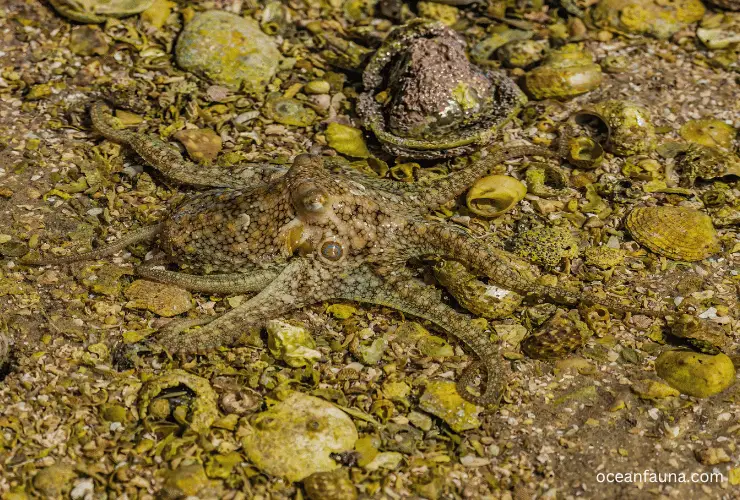
“Their nervous system has a network of synaptic connections between the brain’s circuits and can report on sensory input. This may explain how they can distinguish objects such as prey and predators from other things like sand.
Once a shark caught and swallowed a California two-spot octopus. It then quickly consumes the octopus’s mantle and gills, eliminating its sense of smell and relying on the sharp teeth and claws to remove its brain from the remains.”
She further added,
“According to a study, the California two-spot octopus (Octopus bimaculoides) shares genes with cognitive vertebrates like humans that help with the development of the nervous system. The brainy, complex octopus differs from its less complicated relatives genetically, according to the first comprehensive examination of the octopus’s genome.”
12. Cardiovascular and nervous system
California two-spot octopus has three hearts. The function of one heart is to maintain blood flow to the organs, while the function of the other two hearts is limited to moving blood past the gills. Their hearts stop beating when they swim.
That’s why swimming is difficult for them. This explains why they frequently prefer to walk or crawl rather than swim. Getting out of the water for an aquarium-hunting adventure does require some walking, though.
Octopuses are invertebrates with eight arms that are more closely related to clams and snails than to humans. They are not very human-like. Even so, they are capable of a wide range of complex activities. Thanks to the development of complex neurological systems with as many neurons as those found in canine brains.
Let’s see what Melina Hale, Ph.D., and other experts in the field believe. This implies that they offer a fantastic opportunity to investigate how different nervous system structures can perform the same fundamental duties of limb sensation and movement.
They have now disclosed something novel and completely unexpected about the octopus nervous system in a recent study that was published in Current Biology. They study how the intramuscular nerve cords (INCs), which enable the animal to detect its arm movement, connect the animal’s arms on opposing sides. (Source)
13. Threats and Predators
Octopus species face similar dangers from both human activities and natural predators in the ocean. Climate change is also a significant threat to these creatures. Despite their many differences, they share common risks in their ecosystem.
Let’s see what are the threats and predators of California two-spot octopus, according to the American Oceans organization: (source)
❖ Human Threats
The Two-Spot Octopus is not directly targeted by humans for hunting, but often gets unintentionally trapped in fishing gear. Some fishermen may choose to keep and sell the octopuses they catch, with a limit of 35 specimens per bag. They are mainly utilized as a source of food or as companion animals.
❖ Climate Change and Global Warming
Some people hold differing views on the extent of the influence of climate change and global warming on the Two-Spot Octopus, and other types of octopuses. Scientists think that climate change could decrease the amount of oxygen in the ocean. This could potentially affect the vision of some octopus species that use oxygen to process light for their eyes.
However, studies indicate that different species of octopuses are adaptable to changing ocean temperatures and acidity levels. These studies suggest that octopuses are likely to be able to withstand the impacts of climate change.
❖ Predators
Around 66% of Two-Spot Octopus hatchlings are preyed upon during the first few weeks of their life. It is primarily due to their small size and habitat close to the surface, making them vulnerable to predators.
Its specific predators are moray eels, scorpionfish, and even humans. Other common predators of octopuses include large fish and sharks, dolphins, and birds.
14. Conservation Status
The California two-spot octopus is not currently listed as a species of special conservation concern. This species has not undergone assessment by the IUCN Red List, nor does it possess any unique status according to the US Federal List.
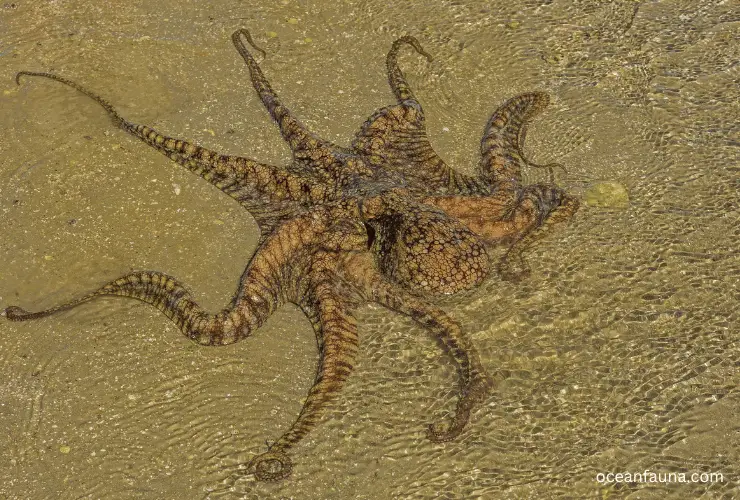
This means that it is not considered to be in danger of becoming extinct or in need of any immediate conservation efforts. However, this does not mean that the species is not facing any threats. These octopuses are vulnerable to overfishing, habitat destruction, and pollution.
In addition, they have a short lifespan and a low reproductive rate, which makes it difficult for their populations to recover from declines. Therefore, it is important to monitor the population of California’s two-spot octopuses and take appropriate conservation measures if their status changes.
15. Economic Importance for Humans
While the California two-spot octopus is not a primary source of food for humans, it can still be caught in traps and nets for sale. In California, there is a daily limit of 35 specimens with no size restrictions. The species is also popular in the pet trade, as its small size makes it suitable for aquariums.
They are often sold for around $30 to $40, depending on their size. However, it is important to monitor the impact of trapping and selling on the population of this species. Why? It is because it can have negative consequences on their ecological role in the ecosystem.
Are California Two-Spot Octopuses Venomous?
No, California two-spot octopuses are not venomous. When compared to the several other species of octopuses that live in the water, the California Two-Spot Octopus has a very distinctive appearance. These amiable but cautious animals are not dangerous to people.
O. bimaculoides is one of the tamest and most friendly octopuses in the world. It slowly creeps and quickly crawls to catch prey from its suckers and beak. It can release ink to get away from predators and humans. However, its deadly ink is not as deadly as the other octopuses.
What Adaptations Does the California Two-Spot Octopus Have?
Let’s go through the most common adaptations of the Bimac octopus:
- They can hunt, hide, and even mate by manipulating their colors to suit their environment.
- The typical 3-foot-long octopus can fool predators and prey into thinking that the blue circular eyespots on each side of the head are the actual eyes on its own body.
- The fact that the octopus can navigate through conditional discrimination is an intriguing adaptation.
- Furthermore, the species may choose the best escape route when presented with two alternative pathways, only one of which is an exit.
What are the Fun Facts about the California Two-Spot Octopus?
Here are some cool fun facts about this special animal:
- If a California two-spot octopus loses an arm in any process, it can regenerate and grow one back in its place. This sounds creepy but it’s an amazingly beautiful and distinct fun fact about this species.
- Due to weariness and malnutrition, females frequently pass away during the gestation of the eggs.
- The California Two-Spot Octopus is one of the friendliest species and, if properly cared for, can make a good pet. However, because of their high intelligence, they have been known to escape aquariums easily.
- Males will probably avoid females until they are ready to mate, at which point they will aggressively pursue them. They will mate with as many of them as they can before their bodies break down.
- This species exhibits more confidence in its natural camouflage than other species and does not hide as frequently in the field.
- They may leak ink to aid in hiding. However, this species is not dangerous to humans, and you will likely flee the situation if you come across one.
- Every octopus has three active hearts, two of which pump blood to the gills and one of which pumps blood to the remainder of the body.
FAQs
How long does California two-spot live?
A California two-spotted octopus can live in the wild for 12 to 18 months on average. In captivity, they have a two-year lifespan.
What is the genus of California two-spot octopus?
California two-spot octopus belongs to the genus of Octopus in the family of Octopodidae. (Source)
How big is a California two-spot octopus?
A California two-spotted octopus can grow up to seven inches (17.5 cm) in height or mantle size. On the other hand, bimac tentacles or arms can reach lengths of 17 to 23 inches (43-58.4 cm). They can grow to be 12 times the size of a goldfish in an aquarium.
How Many California Two-Spot Octopuses Exist Globally?
Studies that provide an exact population estimate for bimac California two-spotted octopuses are lacking.
Who Resides With California Two-Spot Octopuses?
The solitary California two-spotted octopuses frequently go on solitary hunts. They can battle for a desired den while also living in temporary dens. The bimac typically congregates during mating.
Can a California Two-Spot Octopus Swim Quickly?
Scientists have not yet calculated this octopus’s typical swimming speed. Despite their quick swimming, they prefer to hunt invisibly rather than quickly. In the wild, a typical octopus can move at a maximum speed of 25 mph (40 km h).
Conclusion
The California two-spot octopus is an interesting, beautiful octopus that tends to be friendly and outgoing. They are so intelligent and skilled that they have been known to ambush a scuba diver. This California inhabitant is also extremely self-sufficient, using its arms to camouflage itself while feeding or even using tools.
Hope you enjoyed reading this post and learning some interesting facts about the California two-spot octopus. If you have something special to share with us about this captivating species, you can share it with us.

